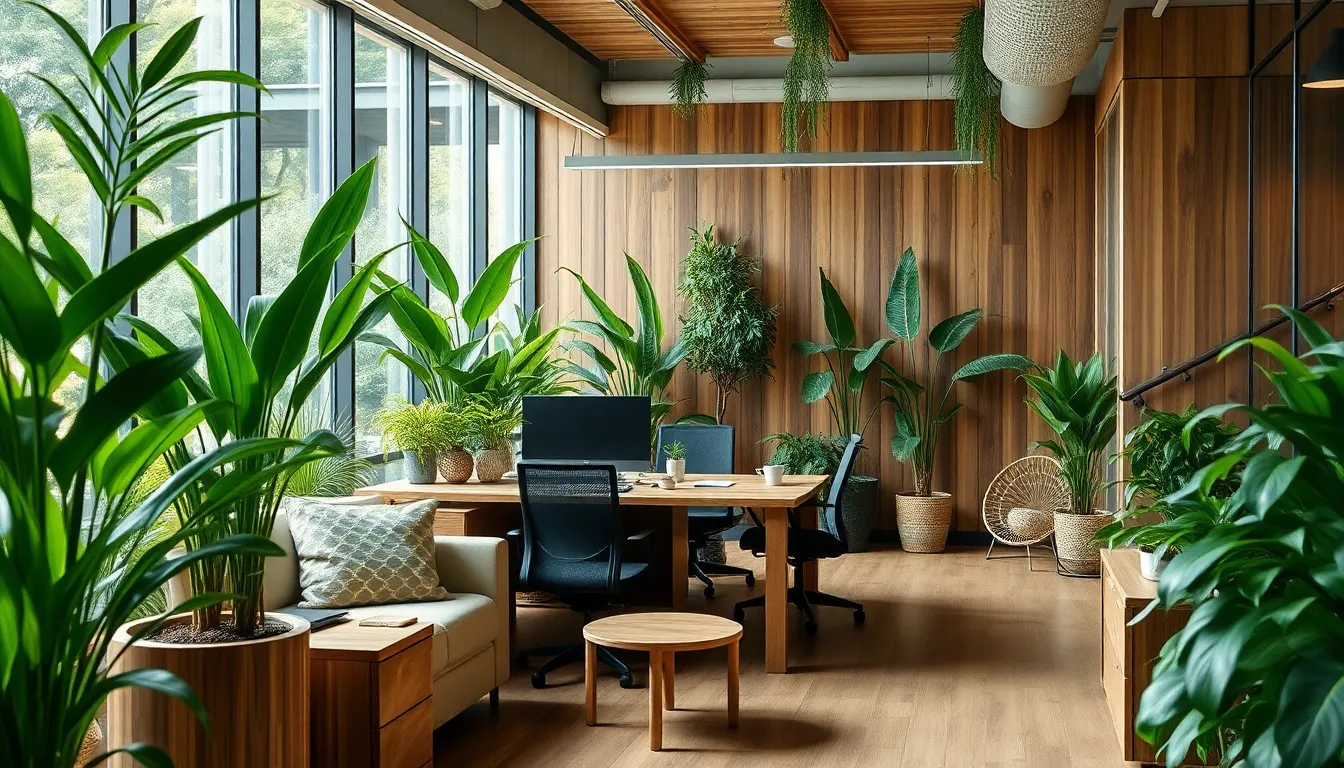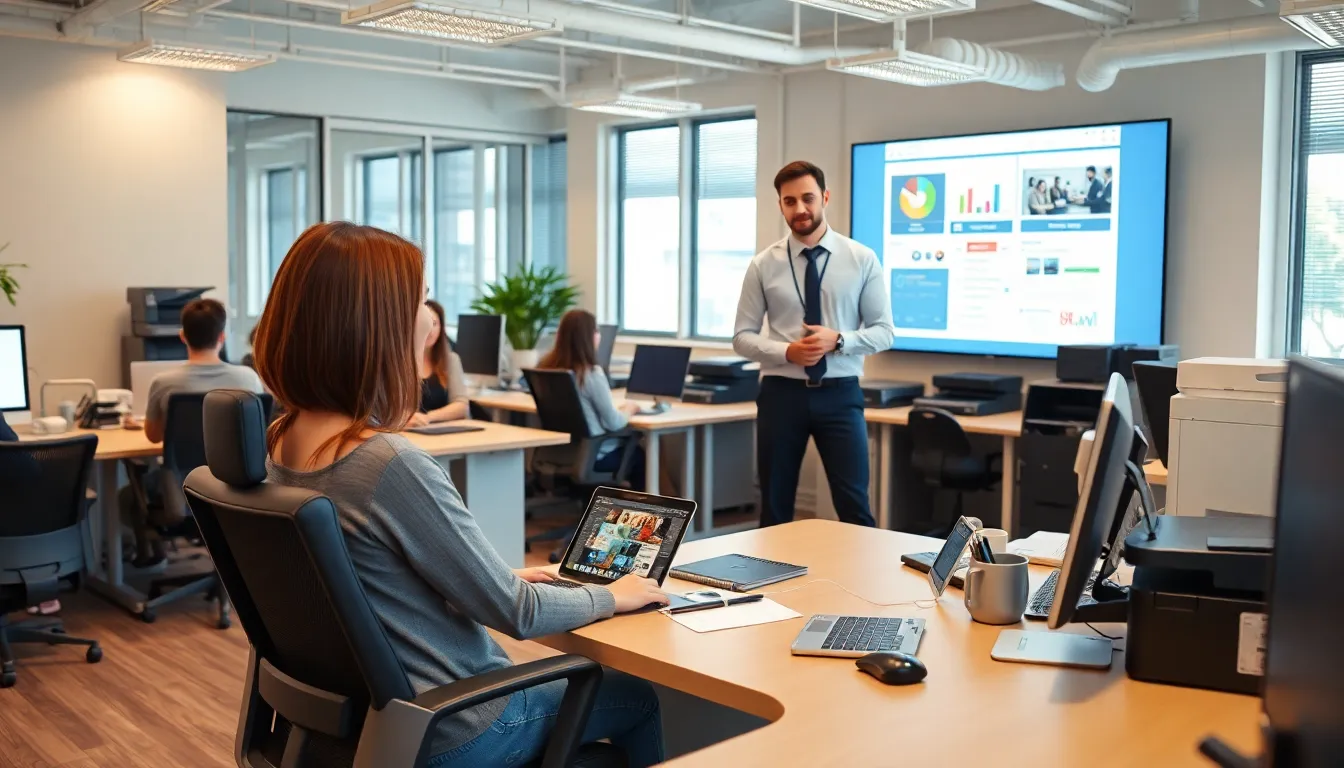Table of Contents
ToggleIn the ever-evolving world of office furnishing, trends come and go faster than a coffee break. What once seemed like a mundane desk and chair combo has transformed into a vibrant playground of creativity and productivity. Today’s office spaces are all about blending functionality with style, making them not just places to work but environments that inspire.
Overview of Office Furnishing Trends
Office furnishing trends display continuous evolution, reflecting changes in workplace culture and employee preferences. Flexible layouts incorporate a mix of collaborative spaces and quiet zones, catering to diverse work styles. Enhanced ergonomics remains a focal point, prioritizing health and comfort with adjustable desks and supportive seating options.
Sustainable materials gain traction as businesses aim for environmentally friendly solutions. Bamboo, recycled plastics, and reclaimed wood create aesthetically pleasing yet eco-conscious office environments. Smart technology integration further shapes modern workspaces, featuring smart desks and connected devices that optimize workflow and user convenience.
Color palettes also play a significant role, with bold hues and calming neutrals making spaces more inviting. Incorporating biophilic design elements, like indoor plants and natural light, promotes well-being and productivity. Art and personalization, once overlooked, now receive more attention, allowing employees to express individuality and foster creativity.
Lighting is essential, influencing both mood and focus. Natural lighting is ideal, but adjustable LED fixtures and task lighting provide flexibility for various tasks. Multi-functional furniture remains popular, enabling seamless transitions between work styles and activities.
These trends illustrate the commitment to creating office environments that are not only functional but also stimulating and sustainable. Embracing these shifts allows companies to enhance employee satisfaction and drive productivity.
Sustainable Office Furnishings

Sustainable office furnishings prioritize environmental responsibility and resource efficiency. Companies increasingly choose options that reduce ecological footprints while enhancing workplace aesthetics.
Eco-Friendly Materials
Eco-friendly materials play a crucial role in sustainable office furnishings. Bamboo offers durability and rapid renewability, making it a popular choice. Recycled plastics also make an impact by decreasing waste and promoting circularity. Cork, another eco-friendly option, is harvested sustainably and provides excellent acoustic properties. These materials not only benefit the environment but also cater to modern design sensibilities.
Biophilic Design
Biophilic design fosters a connection to nature within office spaces. Integrating natural elements enhances employee well-being and productivity. Introducing plants, natural light, and water features creates a calming atmosphere. Furthermore, incorporating elements like wooden textures and earthy colors promotes a sense of tranquility. Designers increasingly adopt biophilic principles to create inspiring and vibrant work environments that resonate with staff.
Flexible Workspaces
Flexible workspaces foster adaptability and innovation within office environments. These modern layouts cater to varied work styles and preferences, enhancing employee satisfaction and productivity.
Modular Furniture
Modular furniture emphasizes versatility and scalability in office design. Designers prioritize interchangeable components to allow easy reconfiguration for specific tasks or team sizes. Tables and chairs can serve multiple purposes, facilitating quick transitions between collaboration and focused work. Pieces that can be rearranged also encourage creativity, allowing employees to customize their surroundings. Brands are increasingly offering eco-friendly modular options, reflecting sustainability trends while maintaining functionality.
Collaborative Areas
Collaborative areas support teamwork and idea generation. Open layouts promote interaction among employees, fostering a sense of community. Spaces featuring comfortable seating arrangements and writable surfaces enhance brainstorming sessions. Designers integrate technology, such as screens and video conferencing tools, to facilitate hybrid work models. Establishing dedicated areas for informal meetings aids in breaking down barriers and encouraging communication. The emphasis on collaboration reflects the importance of socialization in today’s work culture.
Ergonomics in Office Design
Ergonomics plays a crucial role in modern office design. Prioritizing employee comfort significantly boosts productivity and satisfaction.
Importance of Comfort
Focusing on comfort enhances workplace wellbeing. Research indicates that ergonomic workspaces reduce discomfort and fatigue. Employees benefit from improved attention and efficiency in a comfortable environment. Ignoring comfort can lead to health issues like musculoskeletal disorders. Well-designed office elements, such as chairs and desks, promote better posture and support overall health. Integrating comfort also leads to higher employee morale and retention rates. Overall, creating a comfortable office is a strategic investment for any organization.
Adjustable Furniture Options
Adjustable furniture options are vital for promoting ergonomics. Height-adjustable desks allow employees to easily switch between sitting and standing. Such flexibility caters to different body types and personal preferences. Ergonomic chairs often come with adjustable features for lumbar support, armrests, and seat height. Incorporating these elements ensures that everyone finds their ideal setup. These options contribute to a more inclusive work environment, accommodating diverse employee needs. Moreover, investing in adjustable furniture can reduce workplace injuries and absenteeism, enhancing long-term productivity.
Technology Integration
Technology integration plays a pivotal role in shaping modern office environments. Embracing new tools enhances productivity and streamlines workflows.
Smart Office Solutions
Smart office solutions revolutionize traditional workspaces by incorporating advanced technology. Automated systems, like lighting and climate control, adjust to employee preferences, creating a comfortable atmosphere. Smart desks equipped with sensors track usage patterns and promote healthy work habits through reminders to stand or take breaks. The integration of virtual collaboration tools ensures seamless communication among remote and in-office teams. Analytics software helps organizations monitor space utilization, optimizing layouts for efficiency. Implementing these solutions leads to a more engaged workforce and higher satisfaction rates.
Tech-Friendly Furniture
Tech-friendly furniture adapts to the evolving needs of contemporary workspaces. Desks with built-in wireless charging stations provide easy access to power without clutter. Ergonomic chairs often include integrated speakers or headphone connectivity for an enhanced audio experience. Modular workstations feature integrated ports for cables and devices, minimizing visible wires and maintaining a clean appearance. Collaboration tables often come equipped with screens for video conferencing, promoting effective teamwork. Investing in tech-friendly furniture supports a dynamic work environment, catering to diverse work styles and preferences while boosting overall productivity.
Aesthetic Trends in Office Furnishing
Aesthetic trends in office furnishing blend functionality with visual appeal, creating spaces that inspire creativity and productivity. Current designs reflect a focus on comfort and well-being, showcasing how aesthetics can enhance the overall work environment.
Color Schemes and Textures
Neutral color palettes dominate modern offices, fostering calmness and focus. Incorporating shades like beige, gray, and soft pastels creates a serene backdrop while allowing pops of color through accessories and artwork. Textures also play a vital role; combining materials such as wood, metal, and fabric adds depth and warmth to the space. Natural textures connect employees to the environment, promoting well-being. Accent walls featuring vibrant colors or unique finishes can energize the workspace. Variety in textures infuses personality while ensuring an inviting atmosphere.
Minimalism vs. Maximalism
Minimalist designs emphasize clean lines and uncluttered spaces, encouraging clarity of thought and focus. Furniture pieces with simple forms and functional elements dominate these layouts, supporting efficient use of space. Conversely, maximalist approaches embrace bold colors, patterns, and personalized decor, fostering individuality and creativity. Combining elements like eclectic furnishings and statement art pieces creates a vibrant, inspiring environment. Both styles cater to diverse preferences; offices can integrate aspects from both trends for a balanced aesthetic. Prioritizing comfort ensures employees feel at ease in either design approach.
As office furnishing trends continue to evolve they reflect a deeper understanding of employee needs and preferences. The focus on sustainability technology and ergonomics is reshaping workspaces into environments that inspire creativity and enhance productivity. With a blend of functionality and aesthetics businesses are now creating spaces that not only look great but also support diverse work styles.
The rise of flexible layouts and multi-functional furniture caters to the dynamic nature of modern work. By prioritizing employee comfort and well-being companies can foster a culture of collaboration and innovation. Embracing these trends will not only improve workplace satisfaction but also drive overall success in the ever-changing landscape of work.


